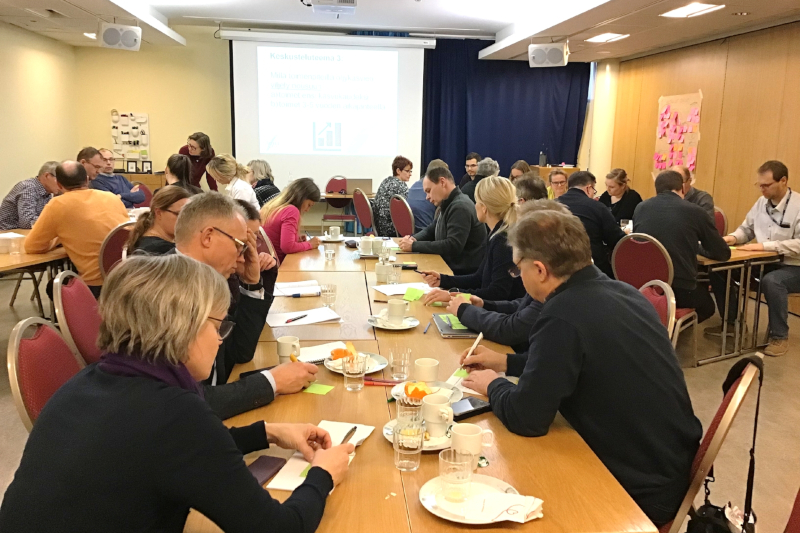
As stated by the HLPE report in 2019, “The global food system is at a crossroads. A profound transformation is needed at all scales in the face of demographic changes, increased pressure and competition over renewable resources, increasingly severe consequences of climatic changes and the loss of biodiversity” (HLPE, 2019). Gaining prominence in the political, scientific and agricultural discourse, agroecology is now recognized as a needed transition pathway towards sustainable food systems.
Since 2007, ISARA has developed strong educational programmes in agroecology. The European Master’s degree in Agroecology together with the Norwegian university NMBU and the joint master programme with Wageningen University (The Netherlands) are key illustrations of this.
Since two decades, research in agroecology and sustainable food systems was increasingly established, bringing together agronomic and human and social sciences with ecological and environmental sciences. This commitment, through transdisciplinary research on agroecology, brought us to question the various elements and interpretations of agroecology that exist today.
References
HLPE. 2019. Agroecological and other innovative approaches for sustainable agriculture and food systems that enhance food security and nutrition. A report by the High Level Panel of Experts on Food Security and Nutrition of the Committee on World Food Security, Rome.
Development of agroecology
Agroecology is today used and implemented by a diversity of projects and stakeholders. This increasing attention could be seen through the development at the European level of a partnership on the topic as well as by the development of public policies at national level – for instance in France (Wezel and David, 2020). Realities taken by the holistic concept of agroecology are diverse and depend on their interpretations, geographical context, history, socio-political context as well as stakeholders. Studying the development of agroecology in different contexts as well as its impact is a necessary step to increase our understanding of the concept and its realities. This overall question was address by the CLAS team through different European projects, such as the UNISECO or AE4EU, as well as projects focusing on the economic performance of agroecology.
References
Wezel A, David C (2020) Policies for agroecology in France : implementation and impact in practice , research and education. 70:66–76. https://doi.org/10.3220/LBF1608660604000
Concepts developed
Through our activity the team is involved in the development of different key concepts linked to agroecology that are today used to build our understanding of it. Below an highlight of some of these concepts:
The 3 elements of agroecology
Agroecology as a term is used since 1930s with a diversity of meaning and embraces a variety of approaches and interpretations as summarized by Wezel et al (2009). This paper conceptualizes the idea that agroecology could be seen either as a scientific discipline, a set of practices or political or social movement.
The figure below summarizes this conceptualization.
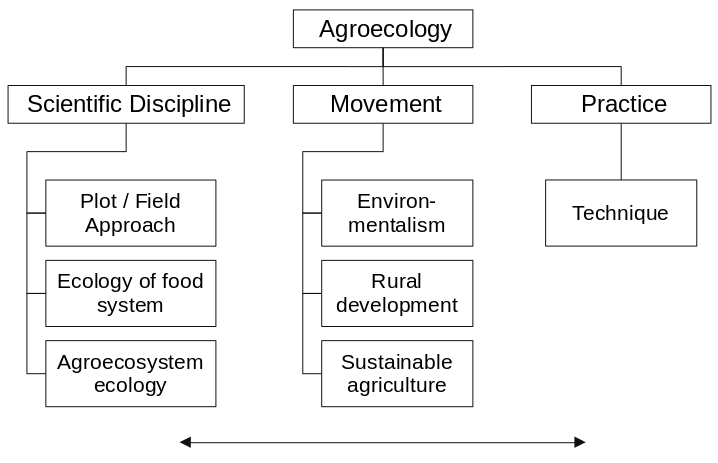
References
Wezel, A., Bellon, S., Doré, T., Francis, C., Vallod, D., David, C. (2009). Agroecology as a science, a movement and a practice. A review. Agronomy for Sustainable Development, 29, 503-515.
13 principles of agroecology
Rooted in the discipline of ecology and agronomy, agroecology developed according to the geographic and social context on various aspects. Recently, a consolidated list of principles was developed and proposed by the High Level Panel of Experts on Food Security and Nutrition of the Committee on World Food Security (HLPE, 2019). This set the definition of 13 agroecological principles that are complementary of the 10 elements proposed by FAO (FAO, 2018). A member of the CLAS had the opportunity to participate in the definition of the 13 principles in the HLPE work.
As stated by Wezel et al. (2020), those principles allow the identification of four key entry points associated with the elements: diversity; circular and solidarity economy; co-creation and sharing of knowledge; and, responsible governance to enable plausible pathways of transformative change towards sustainable agriculture and food systems.
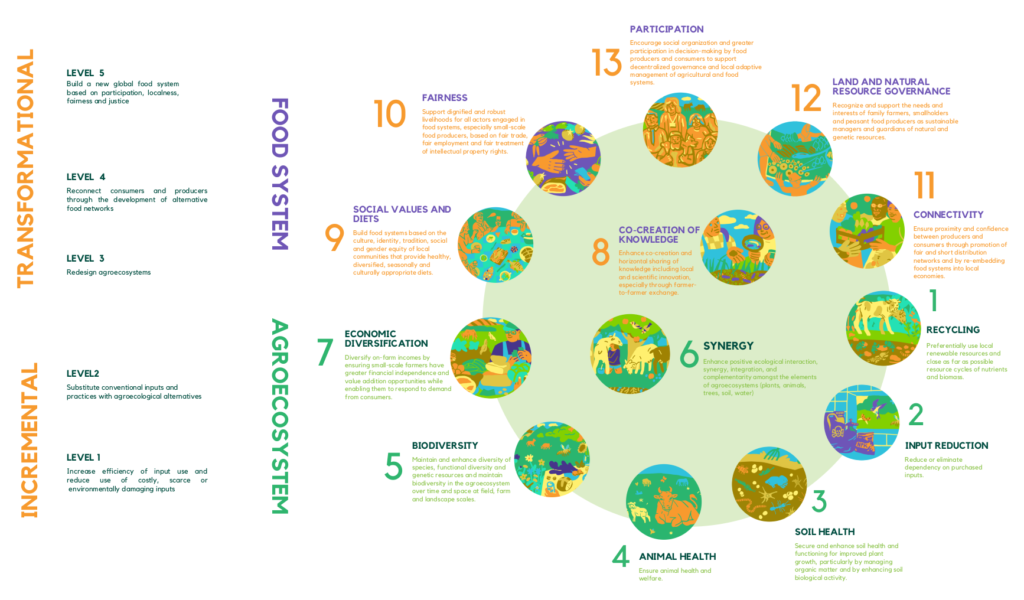
References
FAO. 2018. Agroecology Knowledge Hub. The 10 elements of agroecology. Rome, http://www.fao.org/agroecology/knowledge/10-elements.
HLPE. 2019. Agroecological and other innovative approaches for sustainable agriculture and food systems that enhance food security and nutrition. A report by the High Level Panel of Experts on Food Security and Nutrition of the Committee on World Food Security, Rome.
Wezel, A., Herren, B. G., Kerr, R. B., Barrios, E., Gonçalves, A. L. R., & Sinclair, F. (2020). Agroecological principles and elements and their implications for transitioning to sustainable food systems. A review. Agronomy for Sustainable Development, 40, 1-13
Agroecology territories
Territories are an often neglected scale while being key to apply and foster the development of agroecology. Based on different research projects and the expertise of the team, the concept of agroecology territories was developed (Wezel et al. 2016).
“An agroecology territory can be defined as a territory where:
- a transition toward sustainable agriculture based on agroecological practices exists,
- biodiversity and resource conservation is taken into account,
- territory- linked embedded food systems exist, and
- stakeholders support the transition toward sustainable agricultural and food systems.”
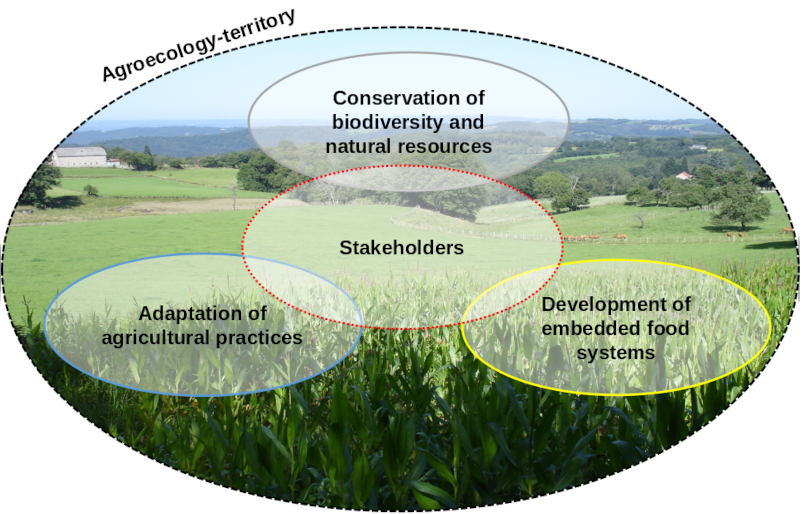
References
Wezel, A., Brives, H., Casagrande, M., Clement, C., Dufour, A., Vandenbroucke, P. (2016). Agroecology territories: places for sustainable agricultural and food systems and biodiversity conservation. Agroecology and sustainable food systems, 40(2), 132-144.
Agroecological practices
The long lasting debate around sustainable agricultural production practices has led to the emergence of different terms including agroecological practices. In 2016, our team proposed a first definition of this concept organized in 15 categories and according to their scale of application (Wezel et al. 2014).
“Agroecological practices are agricultural practices aiming to produce significant amounts of food, which valorise in the best way ecological processes and ecosystem services in integrating them as fundamental elements in the development of the practices, and not simply relying on ordinary techniques, such as chemical fertiliser and synthetic pesticide application or technological solutions, such as genetically modified organisms.” Extracted from Wezel et al. 2014
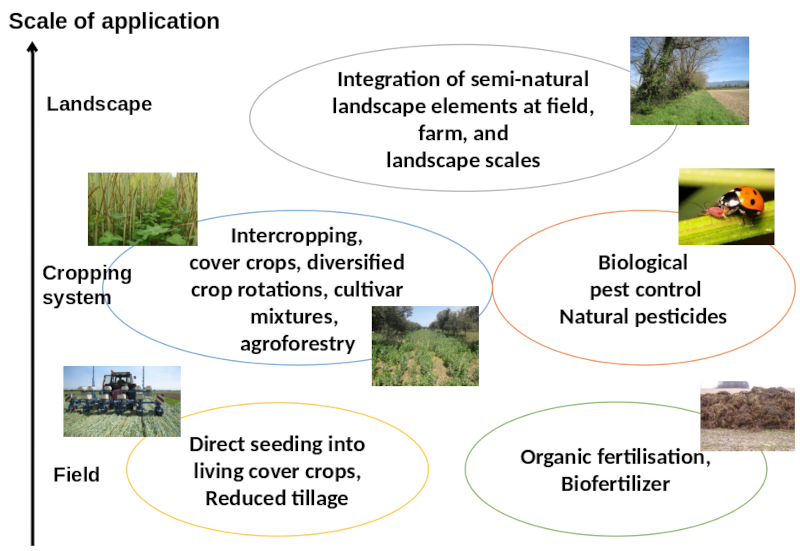
References
Wezel, A., Casagrande, M., Celette, F., Vian, J. F., Ferrer, A., Peigné, J. (2014). Agroecological practices for sustainable agriculture. A review. Agronomy for sustainable development, 34(1), 1-20.
Mid-Scale value chains
SYAMs are distinguished from other food distribution channels (short or long) by their capacity to facilitate collaboration among diverse stakeholders, including farmer groups, vegetable shops, SMEs, wholesalers, foodservice companies, distributors, startups, and local authorities. These partnerships are guided by the objective of developing mutually beneficial supply chain projects. These projects are driven by the construction of “win-win” agreements that enable players to create economic value and share it out among themselves.

